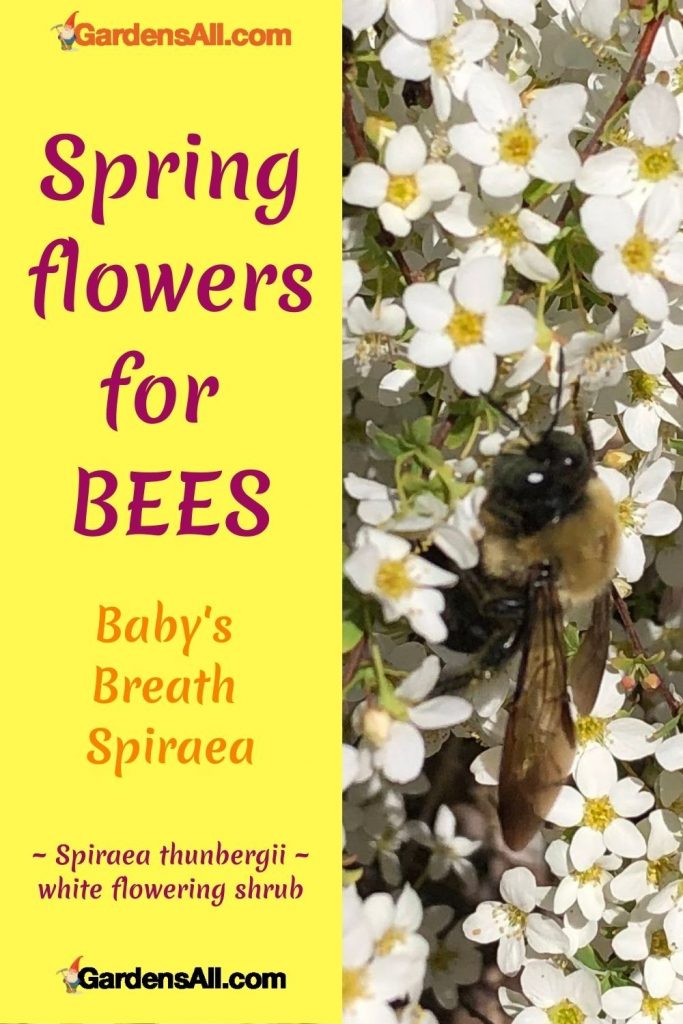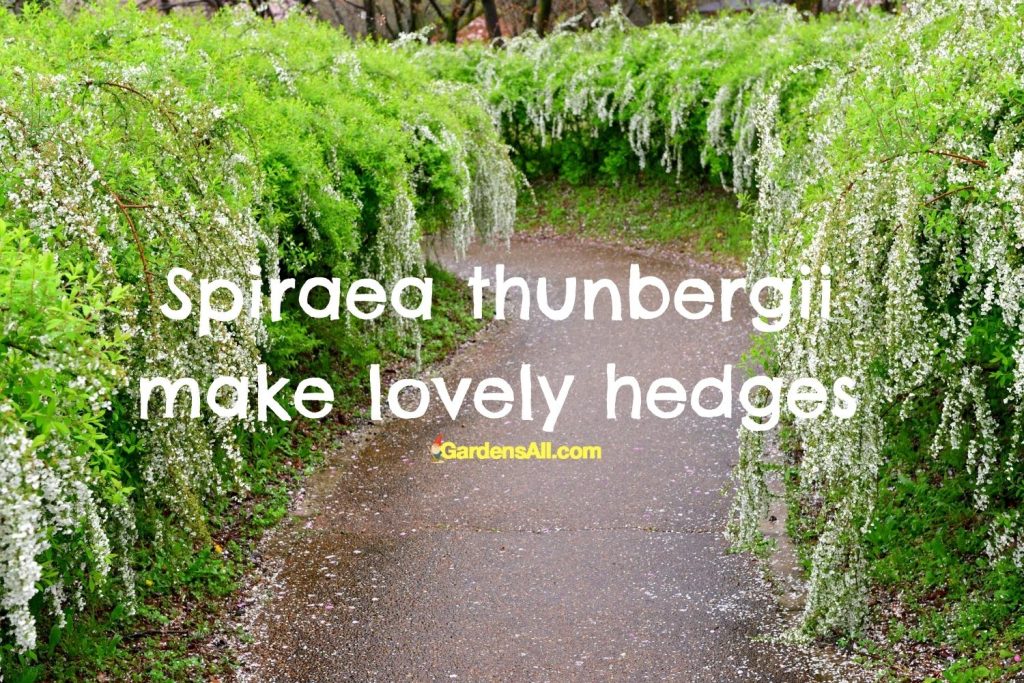An Early Spring Pollinator and Fragrant Perennial Ornamental Landscape Shrub
A favorite early spring flowering shrubs in our garden is the white blossomed Baby’s Breath Spirea, Spiraea thunbergii. These beautiful ornamental shrubs come in white, pink and purple Spiraea and offer landscape interest spring through fall, with ample blossoms for pollinators.
Sometimes spelled as Spirea, this lovely perennial shrub offers early spring pollinator flowers for bees and is the first flowering shrub in our garden.
Spiraea thunbergii Common Names:
- Spiraea thunbergii Siebold ex Blume
- Baby’s Breath Spiraea
- Breath of Spring Spiraea
- Bridal Wreath Spireas
- Double Lady of the Meadow
- European Meadowsweet
- Japanese Spirea
- Meadowsweets
- Queen of the Meadow
- Steeple bushes
- Thunberg’s meadowsweet
- Thunberg spirea

Baby’s Breath Spiraea Appearance
Baby’s breath Spiraea has a lovely cascading waterfall effect in the yard or garden. The graceful fronds of tiny white flowers make a big appearance in any landscape. Planting this ornamental perennial on slopes or hills
Spiraea thunbergii is a popular ornamental landscape plant for gentle slopes or hills that give the weeping branches room to flow.

Growing Spiraea Thunbergii – Baby’s Breath Spiraea
This low maintenance perennial shrub is a beautiful ornamental plant that shows off four-season beauty.
Spirea in spring, showcases baby’s breath style of lacy white flowers beginning in early spring in our zone 7a, to late spring in colder zones. These white blossoms are accompanied by spring green leaves that deepen to a lush summer green foliage.
Spirea is a deciduous shrub with four season landscape appeal, with fall leaves transforming into yellow, gold and orange autumn colors.
Growing Conditions
- FAMILY: Rosaceae (rose family)
- GENUS: Spiraea
- SPECIES: Spiraea thunbergii Siebold ex Blume
- GENUS: Spiraea
- ORIGIN: Japan and China
- LIGHT: Full sun to partial shade
- DIFFICULTY: Easy, drought tolerant, disease resistant and can tolerate poor soil
- SOIL: all types, but prefers moist soil with good drainage
- SIZE: 5 feet tall by 5 feet wide
- COLORS –
- Leaves in spring: golden yellow to green
- Leaves in fall: brown copper to orange
- Flowers: white with yellow center
- USES – in landscape
- ornamental
- flowers
- leaves
- shrub shape
- barrier – ideas for slope or bank
- border
- hedge
- ornamental
- GROW ZONES – 4a-8a
- GROWING –
- PROPAGATE: From seed or stem cuttings
- HERMAPHRODITE: (has both male and female organs)
- SELF FERTILE: no additional spirea needed for cross pollination
- SOIL:
- light (sandy soil)
- medium (loamy soil)
- heavy (clay soil)
- pH: neutral and basic (mildly alkaline) soils
- PRUNE: This spirea flowers on the previous summer’s growth, so should be pruned immediately after flowering in order to promote new growth.
- DISEASE: Fire blight, leaf spot, powdery mildew, root rot (coffee grounds may help here)
- PESTS: Aphids, leaf rollers, scales
Baby’s breath Spiraea is beautiful perennial ornamental shrub that’s attractive to pollinators and good for barrier, border, hedge or stand-alone feature plant.
Spirea Uses in Yard and Garden Landscapes
Spirea bushes are beautiful wherever they’re planted, either in full sun or light shade. Some favorite uses for this beauty is as foundation plants, hedges, large containers, mixed borders, and cameo placement as specimen plants.
The graceful weeping fronds of the Spirea thunbergii are especially lovely on slopes and rock gardens.

Companion Plants for Spirea
- Delphinium, (larkspur)
- Evergreens
- Forsythia
- Fothergilla
- Grasses
- Juniper
- Lavender
- Peony
- Phlox
- Roses / knockout roses
- Spring bulbs
- Viburnum
An Easy Plant, Care Free Ornamental Flowering Shrub
Spirea thunbergii is deer and drought tolerant and pest resistant. spiraea Pests & Diseases:
No plant makes me happier than one that has something interesting to look at in every season, attracts beneficial insects, and comes up every year for a long time.
Medicinal Benefits of Spiraea Thunbergii
While many spireas are edible and medicinal, there isn’t much information readily available specifically on Spiraea thunbergii.
This variety of Spiraea doesn’t seem to be in use as a common natural remedy. There are however, studies indicating that it contains fucoidans which have been found to contain anti-cancerous properties.
Potential Medicinal Benefits of Spirea Thunbergii
- Anti-cancerous
- Antitumor
- Boosts resistance, specifically SAR – Systemic acquired resistance against pathogens[1]https://www.sciencedirect.com/topics/agricultural-and-biological-sciences/spiraea
CAUTION: Any usage should be studied and applied under appropriate medical supervision.
This plant is also sometimes called Thunberg’s meadowsweet, however, it is not the same species of spiraea as the common medicinal meadowsweet, (Filipendula ulmaria) or Spiraea Ulmaria. These and other species of spirea have many known and published edible and medicinal benefits.[2]https://pfaf.org/user/Plant.aspx?LatinName=Spiraea
If you have the spiraea thunbergii or other species of spirea, be sure to do your research first. It’s also advisable to check with a knowledgeable herbalist or natural health practitioner to learn more about the specific known benefits of your species of spiraea.
Choose spirea thunbergii for a 4-season ornamental perennial shrub that will grace your landscape for many years to come, and serve to feed pollinators in early spring.
We also recommend the oh-so-fragrant sweetbox as a flowering evergreen ground cover or low hedge. The blossoms are so tiny as to be overlooked but their fragrance fills the yard and wafts into the house.
I’m LeAura Alderson, a garden, herb and plant enthusiast with a passion for discovering the many edible and medicinal benefits of the plants all around us, including the weeds! I’m a writer, editor and media publisher for our family of websites.
While I was certified in fitness and life coaching, I am NOT a health practitioner. However, I’m a lifelong health enthusiast, with a keen interest in healthy, organic foods and making home remedies and the content we share is from our own experience and usage as well as that extracted from scientific research so that you can explore further on your own.
Always seek the advice and guidance of your health practitioners first and foremost.
As a family we’re steadily expanding our gardening, experimentation and knowledge around all things gardening, edible landscaping, fresh organic foods and self sustainability with farming in our future. I also own and manage iCreateDaily.com, a site all about transformation through creation, and the power of positivity, optimism and mindset.
References

